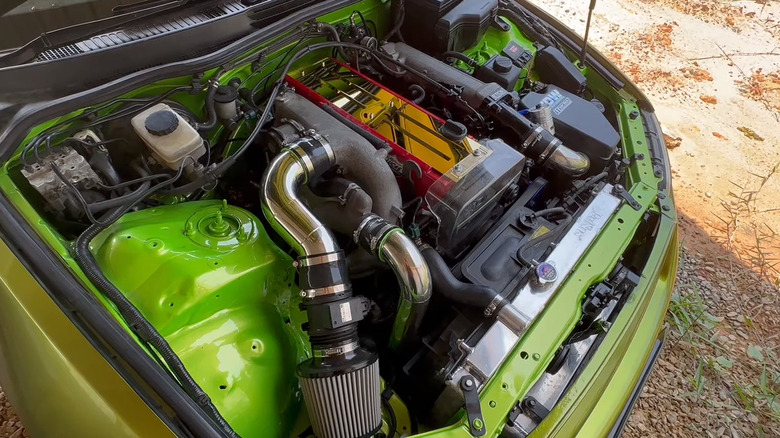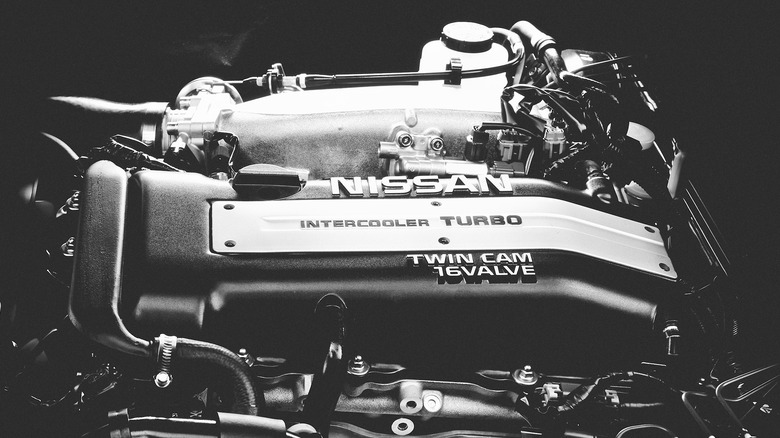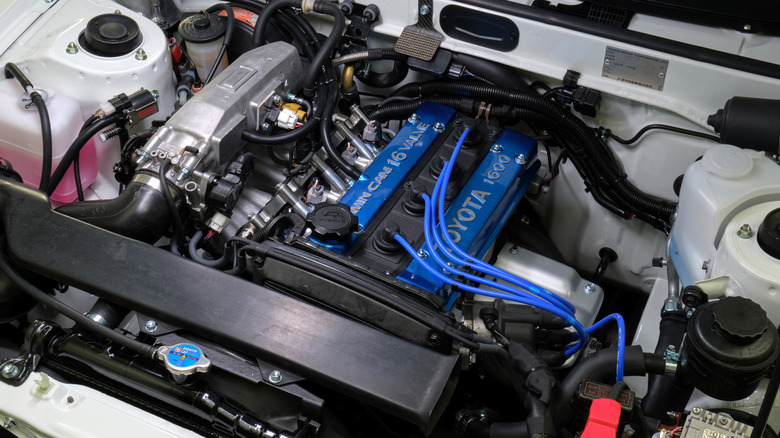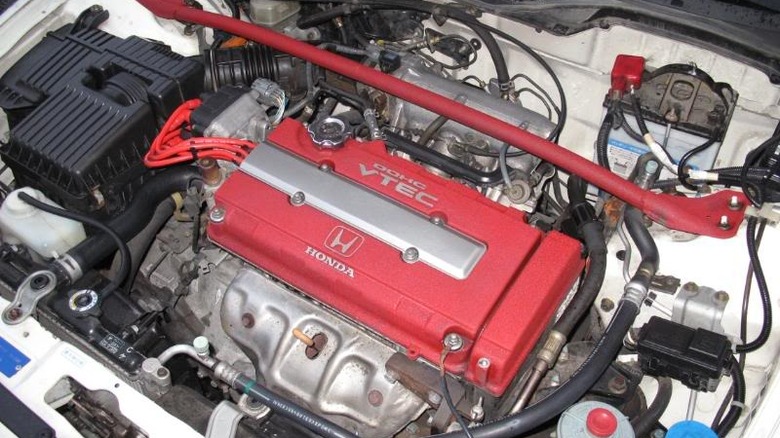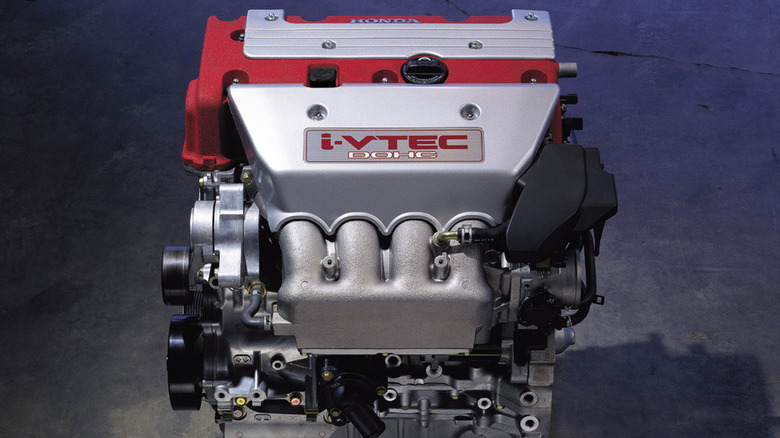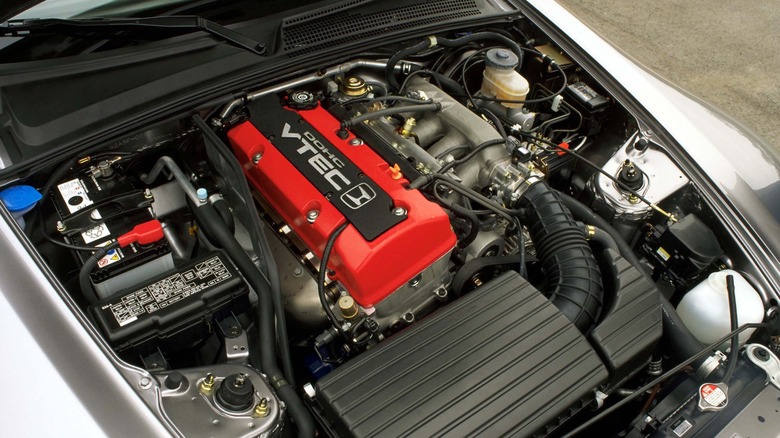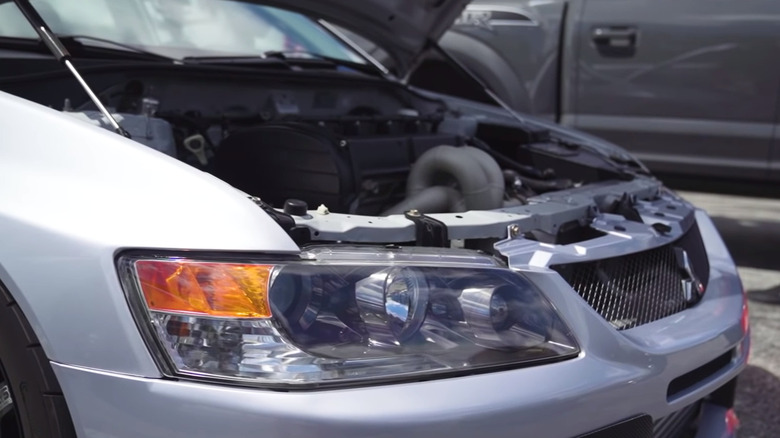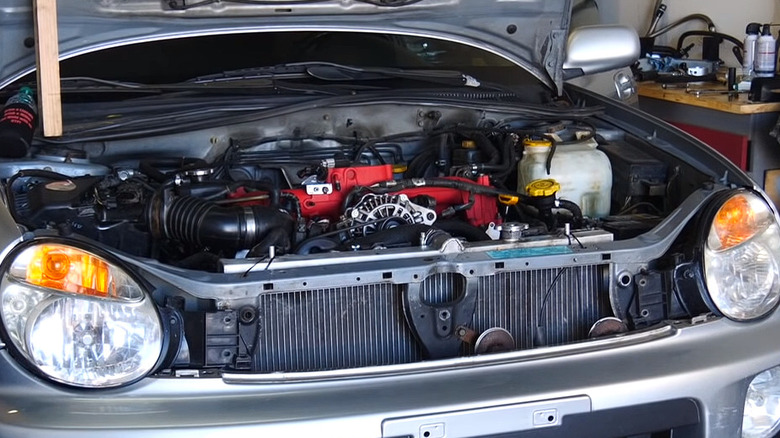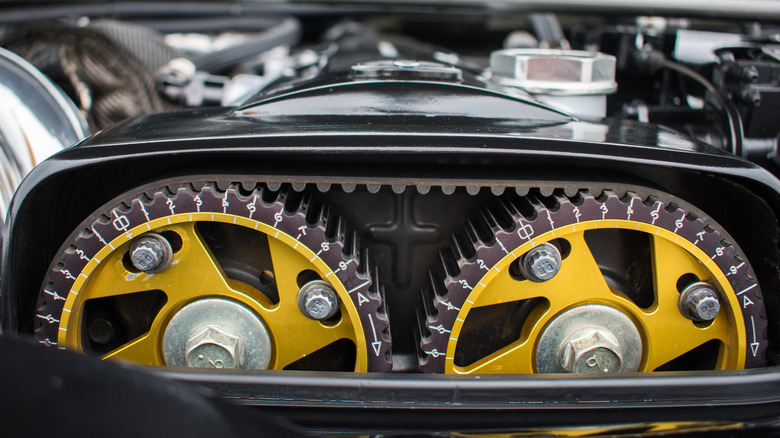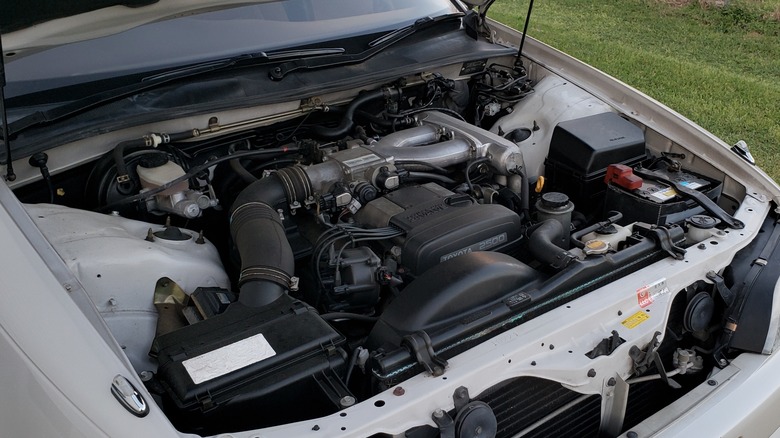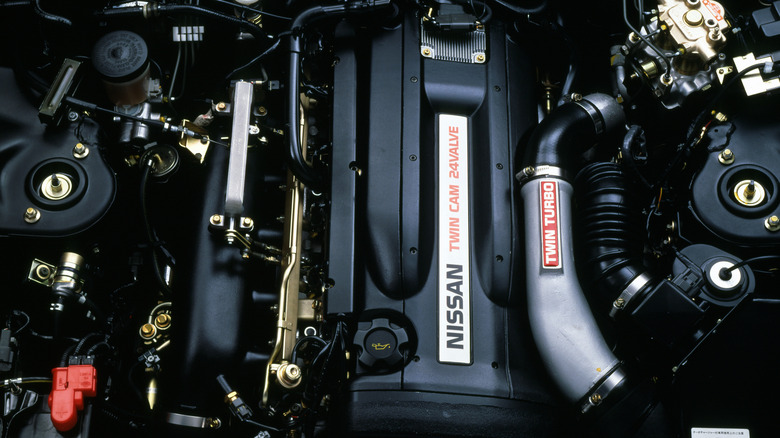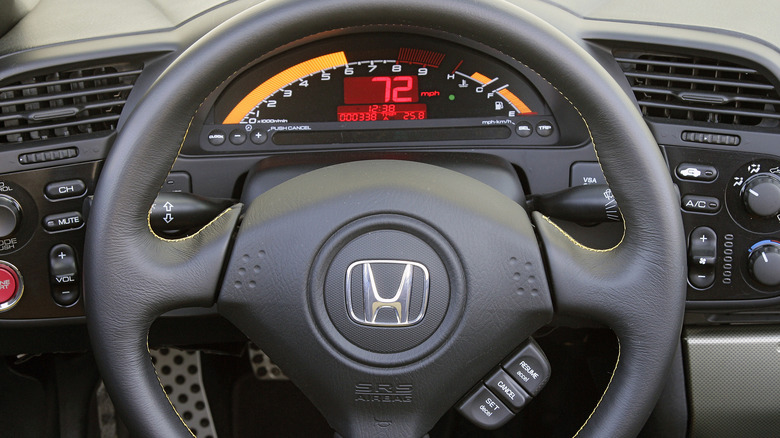10 Of The Best JDM Engines For Your Project Car
From high-revving four-cylinder buzzers to turbocharged beasts, there is a Japanese domestic market (JDM) engine for everyone. Known for their reliability and engineering ingenuity, Japanese engines own the tuning culture, save for perhaps GM's special LS family of V8 small blocks. You will see them in tuned BMWs and Ferraris. They are an integral part of drifting and racing in general. Moreover, they enjoy unrivaled aftermarket support. Crucially, they have a cult following; many enthusiasts swear by JDM engines.
The coolest thing about JDM engines is that there are many recipes on offer. While the USA, for example, is mainly synonymous with the V8, JDM automakers offer a diverse tasting menu, with each engine having a slightly altered recipe. And each one is as delicious as the other; they just tickle your petrol buds in an alternate way. There are four-cylinder rev-happy motors for compact cars, heavily-turbocharged inline-4s for rally icons, and twin-turbo inline-6 powerhouses. Not to mention, you will find motors specifically designed for FWD, RWD, and AWD drivetrain configurations.
But which JDM engine is best for your project car? Well, buckle up because here we will present you 10 great JDM engines that offer a unique experience. The list contains powertrains of all different types, designed to fit every possible drivetrain configuration. In other words, you will surely find a unit that fits the bill!
Nissan SR20DET
Nissan is mainly known for the exceptional inline-6 RB26 engine in its Skyline GT-R sports cars. However, for the majority of enthusiasts out there — particularly those with tighter budgets, the SE20DET is the preferred choice. It is a compact, lightweight, all-aluminum, turbocharged four-cylinder engine from the Silvia that could fit most project cars. Moreover, the 2.0-liter capacity and sound construction mean solid tuning potential. Simple upgrades, like a new turbo, intercooler, intake, cams, or injectors, could bring it close to 400 hp.
From the factory, the SR20DET produces up to 247 hp in the most advanced S15 Black Top version. Meanwhile, earlier versions pump up 205 hp. The upgrades in the newer versions are mainly new ECUs, improved turbochargers, new injectors, and cam profiles. However, the aftermarket support is booming, so you can easily make the upgrades yourself. The SR20DET naturally fits RWD cars, which, along with the compact dimensions and low weight, made it a darling in the RWD drifting community. However, with certain modifications, Nissan's most popular four-cylinder can also fit FWD and AWD projects.
Due to its popularity, Nissan's SR20DET family of engines isn't as cheap as it used to be. Still, prices vary wildly and depend greatly on the engine's condition and completeness. You can snatch one for $3,000, with good-condition units costing upward of $5,000. Meanwhile, fully restored "like new" and tuned SR20DET engines that don't require further modifications cost north of $10,000. Considering the excellent tuning potential of the SR20DET, those prices seem like a bargain.
Toyota 4A-GE
Want to build a lightweight RWD or FWD car that feels like a racecar? Toyota's 4A-GE family might be what you are looking for. This relatively small, naturally aspirated 1.6-liter was introduced in the mid-19802 with arguably the best Corolla ever, the Corolla AE86. The 4A-GE engine immediately captured the attention of enthusiasts with its rev-happy nature, amazing sound, and ubiquitous reliability.
Toyota's famous four-cylinder motor saw several upgrades during its lifespan, making the jump from 16-valve to 20-valve (5 valves per cylinder!), with higher compression ratios. As a result, the Blacktop and Silvertop versions from the 1990s produced 162-167 hp — not bad for a small four-cylinder. Whichever generation you choose, the 4A-GE will give you a great time. It is responsive, likes to flirt with the tachometer's redline, and provides strong acceleration for its size.
However, the 4A-GE enjoys exceptional aftermarket support, both for NA and boosted builds. This engine is particularly interesting for NA enthusiasts, as upgrades like ITBs, reworked heads, longer cam duration, and higher compression ratio can push it close to 200 hp. That doesn't sound like a lot, but it should be enough in a lightweight project car. Besides, the 4A-GE is all about the driving experience — not the speed. That said, turbocharged and supercharged builds with forged internals and reinforced blocks can push past 400 hp.
If you want the legendary 4A-GE in your project car, it will set you back anywhere from $2,000 to $4,000. Not much, considering the fun aspect, but other engines on this list might be a better option if power is your goal.
Honda B16
Honda's B16 family of engines is similar to Toyota's 4A-GE, except it was designed only with FWD cars in mind. Still, Honda's DOHC B16 engines are even more rev-happy (9,000 rpm redline!) and have a higher tuning potential. They are also famous for using Honda's VTEC (Variable Valve Timing and Lift Electronic Control) technology, which lifts the valves at higher rpm for more power.
Most B16 engines are suitable for a project car, with the least powerful ones producing 150 hp. However, the most desirable of the bunch is the B16B, which produces 182 hp from a measly 1.6-liter capacity. Thanks to its high stock output, the B16B is a great swap for many older compact Honda cars without any modification necessary. It might not set your world on fire, but it sounds amazing and revs like a motorcycle engine.
However, you can quickly push it to 200 hp with simple NA modifications, like an ECU map, upgraded exhaust, ITBs, cold air intake, and race cams. Adding High-flow injectors, a higher compression ratio, a lightened flywheel, throttle bodies, a ported/polished head, and an upgraded fuel pump will further increase the power. You can also go the forced induction route – many bolt-on turbocharging/supercharging aftermarket kits are available. However, in that case, new, forged internals are a must.
Today, prices of B16 engines vary dramatically, starting at $2,500. However, if you want one that has all the additional parts and is swap-ready, it will cost you up to $9,000.
[Featured image by Rodney78 via Wikimedia Commons | Cropped and scaled | CC BY-SA 3.0]
Honda K20A
The K20A follows the same recipe as Honda's B16 engines. Small displacement and big power, thanks to VTEC. That's everything this 2.0-liter unit needs to reach 221 hp (217 hp initially) at 8,000 rpm and 159 lb-ft of torque at 6,100 rpm — it even pushed the JDM-only Civic Type R FD2 to 62 mph in just 6.3 seconds.
But it's the way this engine races forward that makes it special. The latest 2023 Civic Type R might be faster, but its turbocharged 2.0-liter motor lacks the personality of the K20A. The older engine has character — it sounds like an angry racing engine when its VTEC kicks in. It also responds blazingly fast to the driver's input. Who wouldn't want that in a project car made for driving enjoyment?
Besides, the K20A is reliable and enjoys outstanding aftermarket support. You can go any tuning route with this engine; naturally-aspirated builds won't give you much more power, just better response, but that is because Honda made the K20A so good from the factory to begin with. Meanwhile, turbocharged K20As can go over 400 hp with simple internal modifications and no reliability issues. For instance, Honda used the same block in its turbocharged K20C1 that produces 306 hp stock.
A used K20A in good condition will set you back from $4,000 to $5,000. The slightly cheaper K20A2 (less than $4,000) from the North American 2022-2024 Acura RSX Type R, which produces 200 hp, is also a great option for a project car.
Honda F20C/F22C
Tired of seeing another high-revving Honda engine? There is a method to the madness — the F20C and F22C are RWD-only masterpieces, developed for the mythical Honda S2000. Honda's roadster has exceptional handling thanks to its near-perfect weight distribution, but although its chassis was great, the engines stole the spotlight.
Simply put — the F20C engine is special. It's perhaps the better option for purists and high-revolution enthusiasts. It has only a 2.0-liter capacity, yet in its JDM guise, it can produce 247 hp (237 hp globally), with the redline arriving at 8,900 rpm. Naturally, the F20C needs to be revved, as its 162 lb-ft (153 lb-ft globally) of torque is underwhelming. Not that this will stop you from enjoying your project car — on the contrary!
Honda introduced the 2.2-liter F22C in the facelifted S2000 in North America. This larger engine packs 240 hp and 162 lb-ft for global markets but, crucially, produces those numbers lower in the rev range. As a result, it isn't always necessary to rev it out, with the redline arriving at 8,200 rpm. Thus, the F22C is more desirable for tuning, particularly if you go the forced induction route.
Frankly, both the F20C and F22C are outstanding, and great for project cars. They work best with the S2000, but can also inject new life into an MX-5 Miata, Toyota AE86, or other RWD JDM sports cars. They are expensive, costing north of $8,000, but they are built like a racing engine and won't complain if you push them hard daily.
Mitsubishi 4G63T
While Honda's four-cylinder engines are all about giving you that racing feel, Mitsubishi's 4G63T is all about power. Think of it as a four-cylinder 2JZ-GTE, and you won't be far off. This 2.0-liter JDM icon can be pushed to 1,000 hp thanks to its super-stiff cast iron block and strong internals, and it will be reliable while doing that. Oh, and unlike other JDM engines, it can fit various configurations, including AWD, RWD, and FWD. Thus, it is not uncommon to see it inside crazy-powerful AE86s and Civics, as well as kit cars.
Mitsubishi's tour-de-force motor made the difference for the rally homologation special Lancer Evolution from 1992-2007, producing up to 280 hp in some versions, stock! With simple modifications like a revised cam profile, intake, exhaust, and ECU tuning, your project vehicle will quickly reach 400 hp at the wheels.
Forced induction kits with larger turbos and forged internals can push that number to a supercar-beating 600 hp. Going past that figure will require significant modifications, but thanks to the strong aftermarket support, even that is doable.
All of this power comes cheap, too. You can find a used 4G63T for as little as $2,750, which is a bargain considering the tuning potential. Before you go and splurge, though, it is important to note that the 4G63T spanned 20 years (1987-2007), and later versions are more advanced and reliable. Those will set you back more than $6,000, but you get a lot of engine for that money.
Subaru EJ205
Subaru's EJ205 is a direct answer to Mitsubishi's 4G63T. It was born in an era when the two brands dominated the rally scene and produced crazy road-legal homologation specials that could race with supercars and win. The two were similar in many ways, though the Subaru Impreza WRX had one important differentiating factor — an EJ20 boxer engine over the front axle. Perhaps the best of them all — at least for your project car — is the 227-hp EJ205.
The 2.0-liter turbocharged flat-four unit adorned the Impreza WRX from 1999 to 2006, competing directly with the 4G63T. Unlike its Mitsubishi rival, the Subaru engine had an aluminum block. Thus, it was lighter, and gave the Impreza a sharper front end, particularly when considering the lower center of gravity courtesy of the boxer construction. These qualities might prove crucial in a project car designed for driving on the track, especially a kit car. Still, the EJ205 is a popular swap for the Subaru BRZ and Toyota GT86 twins and even the classic Beetle, all of which come stock with a boxer engine.
The EJ205 responds well to tuning, with kits that include a new intake, exhaust, turbocharger, and cams available as an aftermarket solution. It can't be pushed to the same heights as the 4G63T, mainly due to the aluminum block, but it should be reliable if taken care of properly. Besides, it is a bargain on the used market, with prices ranging from $1,500 to $4,000.
Toyota 2JZ-GTE
It would be heresy to write a top 10 list of the best JDM engines for project cars without something as special as the 2JZ-GTE. Toyota's legendary twin-turbo inline-6 is built like a tank and perhaps the best engine for high-horsepower builds. Moreover, it was introduced with the Supra MK IV, arguably the best tuner car. It even has its own movie quote from "The Fast & The Furious."
Crucially, it has been fitted to Toyota, Lexus, Mazda, BMW, Ford, Chevrolet, and Nissan models. So, thanks to the unprecedented aftermarket support, you will probably be able to fit it inside your project car. Kits with custom engine mounts are available from many tuning stores, making installation much easier.
You can then do whatever you want with the 2JZ-GTE and extract as much power as you want. The 3.0-liter twin-turbo inline-6 motor produces 320 hp and 320 lb-ft of torque stock; however, thanks to the robust cast-iron block, forged rods, forged crankshaft, and low compression ratio (8.5:1), the 2JZ-GTE is capable of much more. Some tuners have extracted 2,500 hp with serious modifications but retained the stock block. If you are concerned about reliability, 500-600 hp builds with new turbochargers, injectors, and ECU will last for years, especially when paired with forged pistons.
Due to its popularity, the 2JZ-GTE commands a higher price. Solid units without many modifications cost around $8,000, though tuned and restored engines can cost up to $15,000. Unlike most other engines on this list, though, the 2JZ-GTE is officially supported by Toyota via the GR Heritage Parts program, so original parts aren't hard to find.
Toyota 1JZ-GTE
Toyota's 2JZ-GTE is definitely the go-to engine for high-horsepower builds, but it has one weakness — it is heavy. Fortunately, Toyota made a miniature version — the 1JZ-GTE. This is still a twin-turbocharged inline-6 engine with a similar cast iron block design and cylinder heads, now crammed in a 2.5-liter capacity, courtesy of a shorter 71.5 mm (2.81 in) stroke.
Naturally, because the 1JZ-GTE has a lower capacity, it can't compete with 2JZ-GTE in power. However, it is smaller and can fit in more project cars. It is also lighter, so handling response should be better. The engine is built like a tank, so you can easily push it past the stock 280 hp and 279 lb-ft of torque. And thanks to the over-square design, it revs more freely than the 2JZ-GTE.
Toyota knew it had a winner with the 1JZ-GTE and installed it in all sorts of RWD JDM cars, like the sporty Chaser sedan and the MK III Supra in Japan and Australia. This is not unusual, as part-sharing has always been the forte of the company. That's why you can also fit it inside many different Toyotas from the 90s, double the stock horsepower figure easily, and beat most cars at the traffic light. It is also a good swap candidate for other JDM icons, like a Nissan 240SX, and even some German cars, like the Mercedes-Benz 190E.
Because it carries less cachet than its bigger sibling, the 1JZ-GTE is also cheaper, with prices starting at around $4,000.
[Featured image by Mld61294 via Wikimedia Commons | Cropped and scaled | CC BY-SA 3.0]
Nissan RB26DETT
The Nissan Skyline GT-R, particularly the R32, R33, and R34 generations, is famous for being invincible in motorsport. A big part of this dominance was the legendary RB26DETT — a 2.6-liter twin-turbo inline-6 legend designed to race and dominate its rivals. It is a true engineering gem, even by today's standards. Unlike similar twin-turbo engines of the era, like the 2JZ, the RB26DETT is a high-revving design, with a relatively short 73.7 mm (2.9 in) stroke and individual throttle bodies for each cylinder. As such, it provides a racy driving experience that few other turbocharged engines can match.
The RB26DETT also has exceptional tuning potential. Its iron block is very tough and durable (particularly the N1 version), allowing for up to 800 hp without modifications. Getting there might be expensive, but the aftermarket support is second to none. Besides, if you aren't interested in building the fastest project car, you can easily extract 400 hp with the stock turbochargers and injectors. Not bad, considering the RB26DETT made 280 hp and 260 lb-ft from the factory.
The RB26DETT can fit into many RWD and AWD Nissan vehicles, including the 240SX and 300ZX. However, it also found its way into the second Smokey Nagata Toyota Supra, and it is not rare to see it in BMWs. Prices of a complete unit start at around $3,500, but those units will require a significant revamp. It might be better to pay a bit more — RB26DETT engines costing between $6,000 and $7,000 are a much better bet.
How did we determine which engines to include?
Making a list of the best JDM engines for project cars is a serious task, as Japan has given us so many good motors throughout the years. Therefore, to make things simpler, we used a methodology that would guide us through the process. The biggest differentiating factor was reliability, as most enthusiasts building a project car won't leave the engine stock.
Then, we also ensured that there were engines of various sizes, from 1.6-liter to 3.0-liter capacities. The idea is that each one of you should have an option — whether you are building a small compact car or a speed machine. Furthermore, we included naturally aspirated and turbocharged units. And on top of that, you will find engines that were designed with FWD, RWD, and AWD drivetrains in mind. Simply put, there is an option for everyone. Hope you enjoyed the list!
